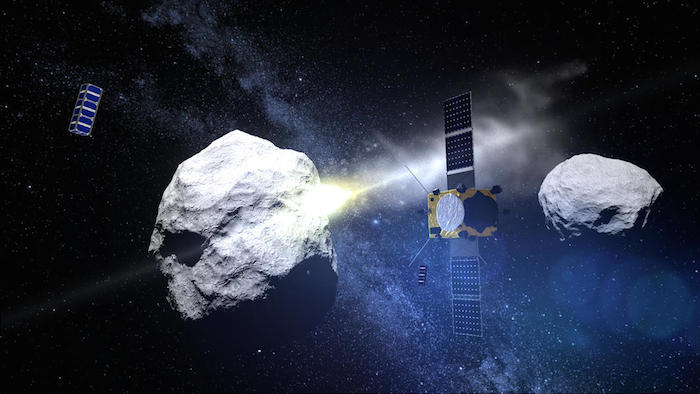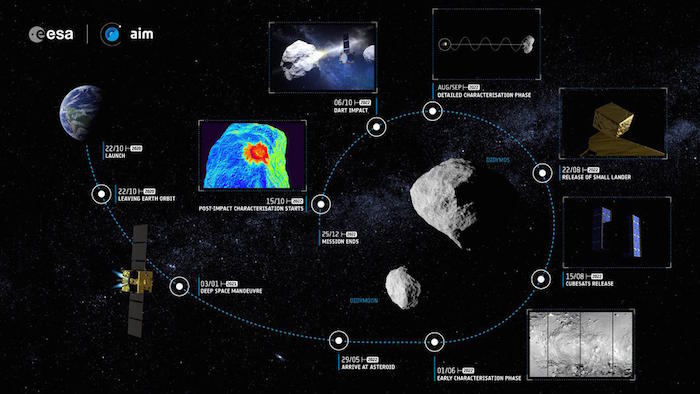.

Bruce Willis can relax: European and North American space agencies have joined forces to prevent an asteroid armageddon. Phil Ritchie reports on the mission.
Asteroids have always posed an extinction-level threat to Earth. Most famously, an impact 65 million years ago wiped out around three-quarters of the Earth’s species, including the non-birdlike dinosaurs.
Luckily, the chance of another cataclysmic collision is so low we’re unlikely to see one anytime soon. Still – even a minuscule chance is a chance, and eventually, our number will come up.
That’s why, in a bid to beef up our planetary defence systems, NASA and the European Space Agency (ESA) may mount the first mission to shove an asteroid out of its normal trajectory – by crashing a spacecraft into it.
The mission, called the Asteroid Impact and Deflection Assessment (AIDA), actually comprises two smaller operations: the Asteroid Impact Mission (AIM), coordinated by the ESA, and the Double Asteroid Redirection Test (DART) on NASA’s end.
If the ESA’s Ministerial Council gives the plan the thumbs up in December, it will transition from concept to reality.
Their target is the 800-metre-wide asteroid 65803 Didymos, or more precisely its 170-metre-wide satellite, dubbed Didymoon.
The asteroid pair will come as close as 16 million kilometres from Earth in 2022 – a perfect opportunity for such an experimental mission, because the asteroids will still be far enough away so there will be no chance of accidentally sending one hurtling towards us.
AIM is the first of the two operations to take flight. It will launch from Kourou in South America aboard a Russian Soyuz-Fregat rocket towards the end of 2020.
Once in space, it will deploy solar panels and manoeuvre towards Didymoon.
Once at its destination, it will orbit the two asteroids and conduct preliminary observations from a safe distance. But it will also be a rendezvous point for DART when it arrives to crash into the little moon some months later, at which point AIM will move out of the way.
AIM’s job is to assess Didymoon’s structure, composition, rotation and orbit and send that information back to Earth. To do so, it will use an assortment of equipment such as thermal and visual cameras, an optical laser and radar.
To assist taking these measurements, several other vessels will drop out of AIM when it’s in orbit.
A Mascot-2 lander, built by the German Aerospace Centre, will land on and conduct an on-site assessment of the asteroid, including its mineral make-up, brightness, temperature and radiation. At least two CubeSats – toaster-sized satellites – will also be deployed from AIM. They will observe from positions too risky for the larger AIM mothership.
.

Part two of the mission – the 300-kilogram DART spacecraft – will depart Earth a few months after AIM. As its name suggests, it will crash into Didymoon at six kilometres per second. Its purpose: to bump Didymoon out of its orbit.
Unlike data-gathering AIM, the only equipment DART will carry is a camera to help its automatic guiding system hit its mark.
AIM will watch closely as DART collides with Didymoon and calculate the results of the impact. And in the aftermath, AIM and its vessels will perform before-and-after comparisons on the structure of the asteroid and its orbit.
Should AIDA get the go-ahead this December, it will mark an important stepping stone as the first time humans have tried shifting a celestial object’s trajectory.
Whether a success or failure, the mission’s data beamed back will be worth the projected mission cost of US$300 million.
As asteroids are scraps left over from the formation of the Solar System, it will provide insights into how ours was formed while providing the groundwork to one day deflect an asteroid – should we be unlucky enough down the track.
Quelle: COSMOS
4481 Views
